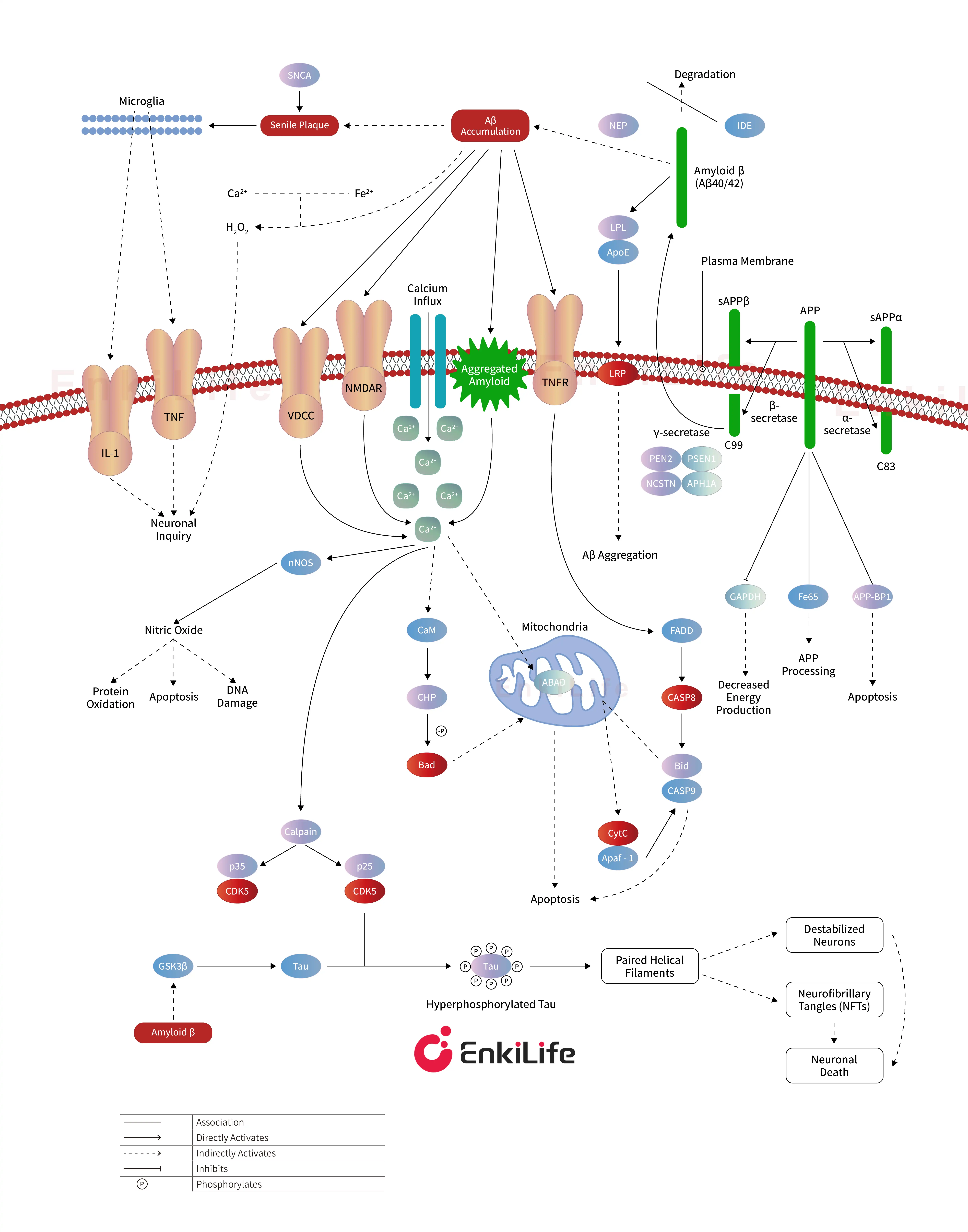Alzheimer's Disease (AD)
Alzheimer's disease (AD) is a progressively developing neurodegenerative disease and the most common type of dementia (approximately 60%-80% of all dementia cases) [1]. Its core features are progressive decline in cognitive functions (such as memory, thinking, language), as well as changes in behavior and personality, which ultimately lead to the loss of the ability to live independently. Existing studies have shown that the occurrence of AD is the result of the interaction of multiple factors such as abnormal protein aggregation, neuroinflammation, genetic factors, etc. [2].
Aβ is a short peptide produced by the cleavage of two proteases, β-secretase and γ-secretase, from "amyloid precursor protein (APP)". In patients with AD, there is an imbalance in Aβ production and clearance – which may result in excessive production and aggregation of Aβ due to mutations in the APP gene (e.g., APP mutations in early-onset AD) or decreased clearance efficiency (e.g., APOE ε4 gene effects). These aggregates can directly damage synapses (the "junction points" that transmit signals between neurons), leading to synaptic dysfunction or even loss (synaptic loss is directly related to memory loss); disrupt the stability of neuronal cell membranes, induce abnormal calcium influx, and interfere with nerve signal transmission; activate microglia ("immune cells" in the brain) and trigger chronic inflammation [3].
Normal tau protein is a "microtubule stabilizer" in neurons - microtubules are the "transport tracks" within neurons responsible for transporting nutrients and signaling molecules, and tau protein maintains its structural stability by binding to microtubules to ensure smooth transportation. In AD patients, tau protein undergoes "hyperphosphorylation," causing it to detach from the microtubules and lose its ability to stabilize the microtubules. Detached tau proteins become entangled with each other, forming "neurofibrillary tangles (NFTs)" that are deposited inside neurons. Microtubule structures disintegrate due to the loss of tau support, and the transport of substances within neurons is completely disrupted, eventually leading to neuronal failure and death. The distribution of NFTs was found to be highly correlated with the degree of cognitive decline in AD patients (e.g., more NFTs in the hippocampus and prefrontal cortex, worse memory and decision-making ability) [4].

Alzheimer's disease mechanism diagram
Alzheimer's Disease-Related Antibodies
| Target | Catalog# | Product Name | Reactivity | Application |
|---|---|---|---|---|
| Aβ pathway-related antibodies | ||||
| APP | AMRe01579 | Amyloid Precursor Protein Rabbit Monoclonal Antibody | Human, Mouse, Rat | WB, IHC-F, IHC-P, ICC/IF |
| BACE1 | APRab07417 | BACE Rabbit Polyclonal Antibody | Human, Mouse, Rat | IHC-P, IF-P, IF-F, ICC/IF, ELISA |
| PSEN1 | AMRe04102 | Presenilin 1 Rabbit Monoclonal Antibody | Human, Mouse, Rat | WB,ICC/IF,IP |
| PSEN1 | APRab16488 | Presenilin 1 Rabbit Polyclonal Antibody Catalog | Human,Mouse,Ra | WB,IHC-P,IF-P,IF-F,ICC/IF,ELISA |
| PSEN2 | AMRe01426 | Presenilin 2 Rabbit Monoclonal Antibody | Human, Mouse, Rat | WB, IP |
| PSEN2 | AMRe01545 | Phospho-Presenilin 2 (Ser330) Rabbit Monoclonal Antibody | Human, Mouse, Rat | WB |
| NCSTN | AMRe04092 | Nicastrin Rabbit Monoclonal Antibody | Human, Mouse, Rat | WB, IP |
| NMDAR1 | AMRe03786 | NMDAR1 Rabbit Monoclonal Antibody | Human, Mouse, Rat | WB |
| TREM2 | APRab03407 | TRIF Rabbit Monoclonal Antibody | Human, Mouse, Rat | WB, IHC-P, ICC/IF |
| GFAP | AMRe21476 | GFAP Rabbit Monoclonal Antibody | Human, Mouse, Rat | WB, IHC, IF, IP, ELISA |
| GFAP | AMRe02031 | GFAP Rabbit Monoclonal antibody | Human, Rat | WB,IHC-P,IP |
| TYROBP | AMRe09784 | DAP12 (15G16) Rabbit Monoclonal Antibody | Human | WB, ICC/IF, FC |
| mAChR | APRab13545 | mAChR M4 Rabbit Polyclonal Antibody | Human, Mouse, Rat | WB, IF-P, IF-F, ICC/IF, ELISA |
| Calpain | AMRe07863 | Calpain 1 (19K17) Rabbit Monoclonal Antibody | Human, Mouse, Rat | WB, IHC-P, ICC/IF, FC, IF-P |
| p35 | APRab15615 | p35 Rabbit Polyclonal Antibody | Human, Mouse, Rat | WB, IHC-P, IF-P, IF-F, ICC/IF, ELISA |
| SORLA | AMRe18116 | SorLA (9J6) Rabbit Monoclonal Antibody | Human, Mouse, Rat | WB, IHC-P, IF-P |
| Tau pathway-associated antibodies | ||||
| CDK5 | AMM03453 | CDK5 (2E8) Mouse Monoclonal Antibody | Human, Mouse, Rat, Monkey | WB, ICC/IF |
| Tau | AMRe02670 | Tau Rabbit Monoclonal Antibody | Mouse, Rat | WB, IP |
| Tau | AMRe06034 | Phospho-Tau (S404) (13R18) Rabbit Monoclonal Antibody | Human, Mouse, Rat | WB, IHC-P, ICC/IF, IF-P |
| SNAP25 | AMRe03813 | SNAP25 Rabbit Monoclonal Antibody | Human, Mouse, Rat | WB, ICC/IF, IP |
| SNAP25 | AMRe02618 | SNAP25 Rabbit Monoclonal Antibody | Human, Mouse, Rat | WB |
| GSK-3β | AMRe03750 | GSK3 beta Rabbit Monoclonal Antibody | Human, Rat, Hamster | WB, IHC-P |
| GSK-3β | AMRe01551 | Phospho-GSK3 beta (Ser9) Rabbit Monoclonal Antibody | Human, Mouse, Rat | WB, IHC-F, IHC-P, ICC/IF |
| Antibodies associated with mitochondrial damage and apoptosis pathway | ||||
| APP-BP1 | AMRe01665 | APPBP1 Rabbit Monoclonal Antibody | Human | WB, IP |
| Apaf1 | AMRe06987 | APAF1 (1L2) Rabbit Monoclonal Antibody | Human, Mouse, Rat | WB, IP |
| Caspase-9 | APRab08970 | Cleaved-Caspase-9 (D330) Rabbit Polyclonal Antibody | Human, Rat, Mouse | IF-P, IF-F, ICC/IF, WB, IHC-P, ELISA |
| TNFR3 | APRab13483 | LTβR Rabbit Polyclonal Antibody | Human,Mouse | WB,IF-P,IF-F,ICC/IF,ELISA |
| DR5 | AMRe10151 | DR5 (3Q11) Rabbit Monoclonal Antibody | Human | WB, IHC-P, IP, IF-P |
| DR5 | AMM03495 | TNFRSF10B (7F4) Mouse Monoclonal Antibody | Human, Mouse | WB, ICC/IF |
| Caspase-8 | AMM03879 | Cleaved-Caspase 8 Mouse Monoclonal Antibody | Human, Mouse, Rat | WB, IHC-F, IHC-P, ICC/IF |
| Caspase-8 | AMM07986 | Caspase-8 (2G12) Mouse Monoclonal Antibody | Human, Mouse, Rat | WB, IF-P, IF-F, ICC/IF, IHC-P |
| APOE4 | APRab07037 | ApoE Rabbit Polyclonal Antibody | Human, Mouse, Rat | WB, IHC-P, IF-P, IF-F, ICC/IF, ELISA |
| ICAM1 | AMRe02131 | ICAM1 Rabbit Monoclonal Antibody | Human | WB, IHC-P, IP |
| CHP | APRab08778 | CHP Rabbit Polyclonal Antibody | Human, Mouse, Rat | WB, ELISA |
| Bad | AMRe05858 | Phospho-Bad (S112) (4M2) Rabbit Monoclonal Antibody | Human, Mouse, Rat | WB, IP |
| Other relevant antibodies | ||||
| Synaptophysin/SYB | AMRe02660 | Synaptophysin Like Protein 1 Rabbit Monoclonal Antibody | Human | WB,IHC-P |
| S100β | AMRe02563 | S100B Rabbit Monoclonal Antibody | Human, Rat | WB, IHC-P, IP |
| iNOS | AMRe12619 | iNOS (12H16) Rabbit Monoclonal Antibody | Human, Mouse, Rat | WB, ICC/IF, IP |
| TNFα | AMM19084 | TNF α (Q34) Mouse Monoclonal Antibody | Human, Rat, Mouse | WB, IHC-P, IF-P, IF-F, ICC/IF |
| TNFα | AMM00896 | TNF alpha (9D9) Mouse Monoclonal Antibody | Human, Rat, Mouse | WB, IHC-P |
| SYN1 | APRab03409 | Synapsin 1 Rabbit Polyclonal Antibody | Human, Mouse, Rat | WB, IHC-F, IHC-P, ICC/IF, ELISA |
| SYN1 | AMRe01536 | Phospho-Synapsin I (Ser9) Rabbit Monoclonal Antibody | Human, Rat | WB, IHC-P |
| NEFL | AMRe01596 | Neurofilament light polypeptide Rabbit Monoclonal Antibody | Mouse | WB, IHC-P, IP |
| NGFR | AMRe14678 | NGFR (18V15) Rabbit Monoclonal Antibody | Human, Mouse, Rat | WB, IHC-P, ICC/IF, FC, IP, IF-P |
| TDP-43 | AMRe02677 | TDP 43 Rabbit Monoclonal Antibody | Human, Mouse, Rat | WB, IHC-F, IHC-P, ICC/IF, IP |
| IL-1β | APRab12530 | IL-1β Rabbit Polyclonal Antibody | Human, Mouse, Rat | WB, IHC-P, IF-P, IF-F, ICC/IF, ELISA |
| IL-1β | APRab03854 | IL-1 beta Rabbit Polyclonal Antibody | Human, Mouse, Rat | WB |
| IL-6 | APRab03851 | IL-6 Rabbit Polyclonal Antibody | Human | WB, IHC-P, ELISA |
| TGF-β | AMM00745 | TGF beta 1 (4C1) Mouse Monoclonal Antibody | Human, Rat, Mouse | IHC-P |
| VEGF-A | AMRe02757 | VEGFA Rabbit Monoclonal Antibody | Human, Mouse, Rat | WB |
| TGF-β | AMM00745 | TGF beta 1 (4C1) Mouse Monoclonal Antibody | Human, Rat, Mouse | IHC-P |
| NMDAR2A | AMRe03787 | NMDAR2A Rabbit Monoclonal Antibody | Mouse, Rat | WB |
| NGFR | AMRe14678 | NGFR (18V15) Rabbit Monoclonal Antibody | Human, Mouse, Rat | WB, IHC-P, ICC/IF, FC, IP, IF-P |
| GAP-43 | AMRe02021 | GAP43 Rabbit Monoclonal Antibody | Human, Mouse, Rat | WB, IHC-F, IHC-P, ICC/IF, IP |
ELISA Kits
| Target | Catalog# | Product Name | Reactivity | Detection Range | Sensitivity |
|---|---|---|---|---|---|
| ICAM1 | ER10795 | Rat ICAM-1/CD54 (intercellular adhesion molecule 1) ELISA Kit | Rat | 0.31-20ng/mL | 0.19ng/mL |
| TNFα | EH10021 | Human TNF-α (Tumor Necrosis Factor Alpha) ELISA Kit | Human | 7.81-500pg/mL | 4.69pg/mL |
| TNFα | EM27661S | High Sensitivity Mouse TNF-α (Tumor Necrosis Factor Alpha) ELISA Kit | Mouse | 1.56-100pg/mL | 0.93pg/mL |
| IL-1β | EM27654S | Mouse IL-1β (Interleukin 1 Beta) ELISA Kit | Mouse | 3.13-200pg/mL | 1.87pg/mL |
| IL-6 | EM21023S | High Sensitivity Mouse IL-6 (Interleukin 6) ELISA Kit | Mouse | 0.781-50pg/mL | 0.47pg/mL |
| IL-6 | EH10020 | Human IL-6 (Interleukin 6) ELISA Kit | Human | 1.56-100pg/mL | 0.94pg/mL |
| VEGF-A | EM10657 | Mouse VEGF-A (Vascular Endothelial Cell Growth Factor A) ELISA Kit | Mouse | 31.25-2000pg/mL | 18.75pg/mL |
Related Products
References
[1] Mintun MA, Lo AC, Duggan Evans C, Wessels AM, Ardayfio PA, Andersen SW, Shcherbinin S, Sparks J, Sims JR, Brys M, Apostolova LG, Salloway SP, Skovronsky DM. Donanemab in Early Alzheimer's Disease. N Engl J Med. 2021 May 6;384(18):1691-1704. [PMID: 33720637].
[2] Le W, Shen L, Guo T, Xie F. Spotlight on Alzheimer's disease and related dementias research in East Asia. Alzheimers Dement. 2025 Jul;21(7):e70479.70479. [PMID: 40641055].
[3] Reiten OK, Wilvang MA, Mitchell SJ, Hu Z, Fang EF. Preclinical and clinical evidence of NAD+ precursors in health, disease, and ageing. Mech Ageing Dev. 2021 Oct;199:111567. Epub 2021 Sep 10. [PMID: 34517020].
[4] Thapa S, Anastassiadis C, Vasilevskaya A, et al. Distinct inflammatory profiles in young-onset versus late-onset Alzheimer's disease. Alzheimers Dement. 2025 Jul;21(7):e70509. [PMID: 40709479].
 | Flora Flora is a technical support expert at EnkiLife, familiar with immunology and neuroscience, dedicated to providing customers with high-quality product combinations and technical support to help achieve research in neurodegenerative diseases and other neuroscience areas. |
